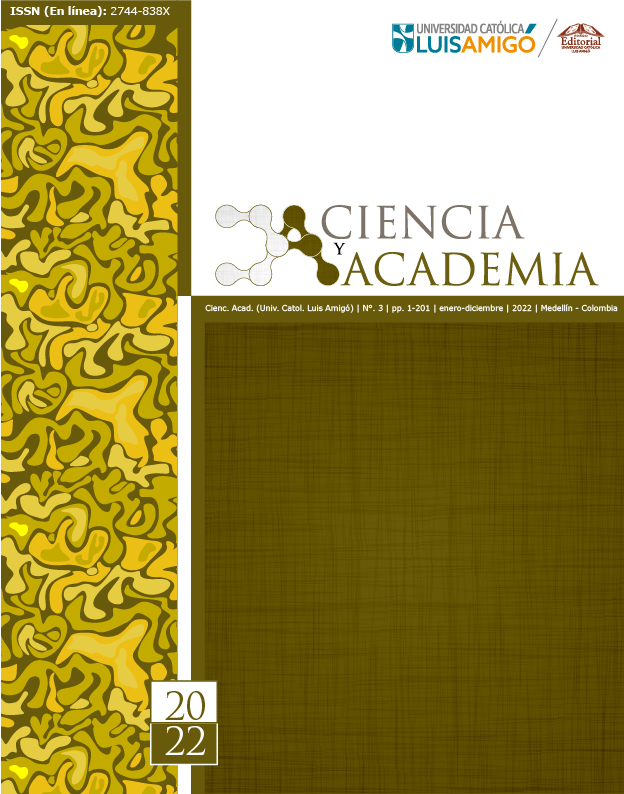Burnout syndrome in nursing assistants during the pandemic of COVID-19
DOI:
https://doi.org/10.21501/2744838X.4492Abstract
This descriptive work aims first to estimate the prevalence of Burnout Syndrome during the COVID-19 pandemic and the posible realationship with some triggers of this condition in a group of 34 nursing assistants from a fourth-level public hospital. Of the Municipality of Envigado in Colombia, and secondly to raise the posible consequences and affectation suffered by the assistants by the aforementioned síndrome, in both family and work aspects. Fort he calculation of the sample, the Epidat application versión 4.2 was used. The research approach is quantitative, for the collection of information the Maslach Burnout Inventory (MBI) questionnaire was used as an instrument, its corresponding análisis was carried out with the help of the Janovi program versión 1.6.23. In order to articulate the information and obtain the other important data that could not be achieved only with the questionnaire, the research presents a qualitative component, for which instruments such as a survey and focus group were used. The result obtained on burnout showed a global prevalence of 11.8% and according to the information obtained with the qualitative component it is presumed that the conditions of the current pandemic could influence the development of this síndrome, directly affecting the auxiliaries nursing and its environment.
Downloads
References
Arteaga-RomanÍ, A., Junes-Gonzales, W., & Navarrete-Saravia, A. (2014). Prevalencia del Síndrome de Burnout en personal de Salud. Revista Médica Panacea, 4(2), 40–44. https://doi.org/10.35563/rmp.v4i2.165
De Kock, J. H., Latham, H. A., Leslie, S. J., Grindle, M., Munoz, S. A., Ellis, L., Polson, R., & O'Malley, C. M. (2021). A rapid review of the impact of COVID-19 on the mental health of healthcare workers: implications for supporting psychological well-being. BMC Public Health, 21(1), 104. https://doi.org/10.1186/s12889-020-10070-3
Freudenberger, H. J. (1974). Staff Burn-Out. Journal of Social Issues, 30(1), 159-165. https://doi.org/10.1111/j.1540-4560.1974.tb00706.x
Gil Monte, P., & Peiro, J. M. (1999). Perspectivas teóricas y modelos interpretativos para el estudio del síndrome de quemarse por el trabajo. Anales de Psicología, 15(2), 261-268. https://revistas.um.es/analesps/article/view/30161
Gutiérrez-Lesmes, O. A., Loboa-Rodríguez, N. J., & Martínez-Torres, J. (2017). Prevalencia del Síndrome de Burnout en profesionales de enfermería de la Orinoquia colombiana, 2016. Universidad y Salud, 20(1), 37–43. https://doi.org/10.22267/rus.182001.107
Hederich-Martínez, C., & Caballero-Domínguez, C. C. (2016). Validación del cuestionario Maslach Burnout Inventory-Student Survey (MBI-SS) en contexto académico colombiano. CES Psicología, 9(1), 1-15. https://revistas.ces.edu.co/index.php/psicologia/article/view/3511
Kameg, B. N., Fradkin, D., Lee, H., & Mitchell, A. (2021). Mental wellness among psychiatric-mental health nurses during the COVID-19 pandemic. Archives of Psychiatric Nursing, 35(4), 401–406. https://doi.org/10.1016/j.apnu.2021.05.003
Leiter, M. P., & Maslach, C. (1988) The impact of interpersonal environmet onburnout and organizational commitment. Journal of Organizational Behavior, 9(4), 297-308. https://doi.org/10.1002/job.4030090402
Maslach, C., & Jackson, S. E. (1981). The measurement of experienced burnout. Journal of Occupational Behaviour, 2(2), 99-113. https://doi.org/10.1002/job.4030020205
Maslach, C., & Jackson, S.E. (1981). Maslach Burnout Inventory Manual. Consulting Psychologists Press.
Maslach, C., & Jackson, S.E. (1986). Maslach Burnout Inventory-Educators Survey. Consulting Psychologists Press.
Maslach, C., Jackson, S. E., & Leiter, M. P. (1996a). MBI: Maslach burnout inventory. CPP, Incorporated.
Maslach, C., Jackson, S. E., & Leiter, M. P. (1996b). Maslach burnout inventory. Consulting Psychologist Press.
Maslach, C., Schaufeli, W. B., & Leiter, M. P. (2001). Job Burnout. Annual Review of Psychology, 52, 397-422. https://doi.org/10.1146/annurev.psych.52.1.397
Meza Benavides, M., Pollán Rufo, M., & Gabari Gambarte, M. I. (2006). Estrés laboral en enfermería hospitalaria: un estudio sobre evaluación cognoscitiva y afrontamiento. Huarte de San Juan. Psicología y Pedagogía, (13), 103-120. https://hdl.handle.net/2454/9461
Meda Lara, R. M., Moreno Jiménez, B., Rodríguez Muñoz, A., Morante Benadero, M. E., & Ortiz Viveros, G. R. (2008). Análisis factorial confirmatorio del MBI-HSS en una muestra de psicólogos mexicanos. Psicología y Salud, 18(1), 107-116. https://doi.org/10.25009/pys.v18i1.681
Miranda-Lara, V. R., Monzalvo-Herrera, G., Hernández-Caballero, B., & Ocampo-Torres, M. (2016). Prevalencia del síndrome de burnout en personal de enfermería de dos instituciones de salud. Revista de Enfermería del Instituto Mexicano del Seguro Social, 24(2), 115-122. http://www.medigraphic.com/pdfs/enfermeriaimss/eim41 2016/eim162g.pdf
Miravalles, J. (2017) Cuestionario de Maslach Burnonventory. Gabinete Psicológico. http://www.javiermiravalles.es
Pérez, C., Parra, P., Fasce, E., Ortiz, L., Bastías, N., & Bustamante, C. (2012). Estructura factorial y confiabilidad del inventario de burnout de Maslach en universitarios chilenos. Revista Argentina de Clínica Psicológica, 21(3), 255-263. http://www.redalyc.org/articulo.oa?id=281929021006
Quiceno, J. M., & Vinaccia Alpi, S. (2007). Burnout: "síndrome de quemarse en el trabajo (SQT)”. Acta Colombiana de Psicología, 10(2), 117-125. https://actacolombianapsicologia.ucatolica.edu.co/article/view/218
Raudenská, J., Steinerová, V., Javůrková, A., Urits, I., Kaye, A. D., Viswanath, O., & Varrassi, G. (2020). Occupational burnout syndrome and post-traumatic stress among healthcare professionals during the novel coronavirus disease 2019 (COVID-19) pandemic. Best Practice & Research. Clinical Anesthesiology, 34(3), 553–560. https://doi.org/10.1016/j.bpa.2020.07.008
Restrepo-Ayala, N. C., Colorado-Vargas, G. O., & Cabrera-Arana, G. A. (2005). Desgaste emocional en docentes oficiales de Medellín, Colombia, 2005. Revista Salud Pública, 8(1), 63-73. https://revistas.unal.edu.co/index.php/revsaludpublica/article/view/96085
Schaufeli, W. B., Martínez, I. M., Pinto, A. M., Salanova, M., & Bakker, A. B. (2002). Burnout and engagement in university students: A cross-national study. Journal of Cross-Cultural Psychology, 33(5), 464-481. https://doi.org/10.1177/0022022102033005003
Toon, W. T, Leblanc, P. M., Schaufeli, B. W, & Schreurs, P. J. G. (2005). Are there causal realtionships between the dimensions of the Maslach Burnout Inventory? A review and two longitudinal tests. Work & Stress, 19(3), 238-255. https://doi.org/10.1080/02678370500270453
Published
Versions
- 2022-09-14 (2)
- 2022-09-06 (1)
How to Cite
Issue
Section
License
Copyright (c) 2022 Ciencia y Academia

This work is licensed under a Creative Commons Attribution-NoDerivatives 4.0 International License.
La revista y los textos individuales que en esta se divulgan están protegidos por las leyes de copyright y por los términos y condiciones de la Licencia Creative Commons Atribución-No Comercial- 4.0 Internacional. Permisos que vayan más allá de lo cubierto por esta licencia pueden encontrarse en http://www.funlam.edu.co/modules/fondoeditorial/






